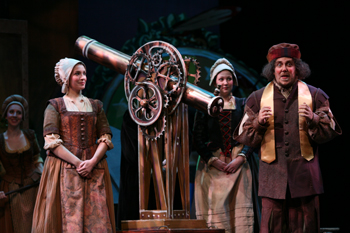by Daniel Hathaway
The opera
Stage directors Jonathon Field (Oberlin) and David Bamberger (CIM) had both aesthetic and practical reasons for choosing the Fall opera titles. “Il matrimonio is a wonderful, delightful piece that I directed once before for Cleveland Opera”, Bamberger told us in a phone conversation, “and it showcases our students well”. Field made his choice in conversation with his colleagues: “Last year the voice faculty became enthused about Il mondo della luna because there are a lot of roles for women. There’s a huge number of sopranos in the department and then an equal number of mezzos, tenors and basses. You need to be sure that you are educating as many students as possible.”
Coincidentally, the two shows had their premieres fifteen years apart and not so far from each other. Haydn’s opera was first performed at the opulent palace of the Eszterházy family in Hungary on August 3 of 1777 for the nuptials of Count Nikolaus Esterházy and the Countess Maria Anna Wissenwolf (only two years before the palace’s 400-seat opera house burned down!) Cimarosa’s was first produced on February 7 of 1792 at the Imperial Hofburg Theatre in Vienna with the opera-going public in mind.
Il mondo della luna, with a libretto by Carlo Goldoni which had been set by four other composers before Haydn took it on, tells the story of a bogus astronomer who dupes the gullible into believing that his telescope has magical powers and that his elixir can transport them to the moon (along with many subplots). Il matrimonio segreto was adapted by Giovanni Bertati from David Garrick and George Colman’s play, The Clandestine Marriage, and is essentially a story about the wrong people falling in love with each other.
Everybody knows about Haydn, but Cimarosa is less of a household name. “Cimarosa was the chief composer of Italian operas of his time”, Bamberger noted. “Mozart was the oddball. He was a genius but, like Sondheim today, nobody knew what to do with him. Cimarosa was in the service of Catherine the Great but his wife got tired of Russian winters. When he won his release, the Emperor called him to Vienna to the job Mozart had always wanted. After the premiere of Il matrimonio, the Emperor was so pleased that he told the singers to go have dinner and then repeat the whole thing. I think it’s safe to say this is the only time in history an entire opera has been encored.”
Field was instantly drawn to the story line of Il mondo, while recognizing the challenges of staging it. “I read the libretto and it sounded great. Act I, Scene II takes place on the moon, so what could be better? The librettist was working from Commedia dell’arte characters — the Ren and Stimpy of theater. It’s stuff that is over the top and bawdy and I had to come up with a way to make it walk that fine line between three-dimensional comedy and farce.”
Both directors have decided to set their productions outside of their original time periods. Bamberger has opted for the U.S. Around 1910. “The story line involves a nouveau riche merchant who wants to marry into a noble family. He sets up his oldest daughter to marry a count, but he ends up falling in love himself — with the count’s younger daughter. The basic sociological problem of wanting to rise into the nobility lasted at least until World War I. So our approach has been inspired by Downton Abbey. The only difference between the two is that in Downton Abbey we’re in the home of a nobleman who has married a rich American wife and in this case we’re in the home of the rich American wife. You could imagine that he was showing up on Millionaires’ Row in Cleveland in 1910.”
Field said “I’m always playing around with time periods. I realized that Il mondo couldn’t be placed in a modern era because, after a certain point, women are not going to be putting up with nonsense and will be making their own decisions. You can’t put it in the 1800s because by that point science and technology has evolved into the general society and the awe that Buonafede feels from getting the information about the moon from a learned man is no longer valid. Then I realized that from about 1610 to 1620 you had a late Elizabethan, early Jamesian society with patriarchal families where the father controls everything and women do not have a whole lot of options. I also found out that the telescope was invented around 1608, so by 1610 it had worked its way through Europe as cutting-edge technology, and now it makes sense for a person to go gaga over a telescope.”
Both shows are comedies, and while Bamberger feels that the humor in Il matrimoniocomes across very well on its own — “I changed only one word in the score to update it” — Field has taken pains to make sure that the humor in Il mondo comes across the footlights. “It’s not as easy as people may think. We’re playing to a generationally mixed audience and we have to have something for both. The challenge is to keep it funny and topical while remaining true to the time period we’re in”.
Click here to comment on this article. All comments will be moderated by the editorial staff.
Published on ClevelandClassical.com November 6, 2012
Click here for a printable version of this article.


